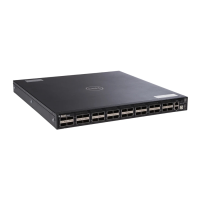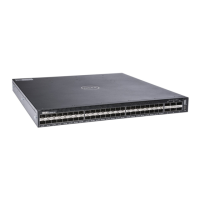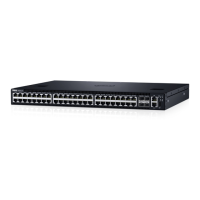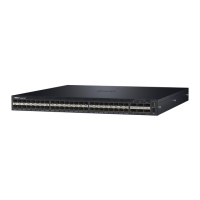• If the management port is down or route lookup fails in the management EIS routing table, packets
are dropped.
• For all non-management applications, traffic exits out of either front-end data port or management
port based on route lookup in default routing table.
• Ping and traceroute are always non-management applications and route lookup for these
applications is done in the default routing table only.
• For ping and traceroute utilities that are initiated from the switch, if reachability needs to be tested
through routes in the management EIS routing table, you must configure ICMP as a management
application.
• If ping and traceroute are destined to the management port IP address, the response traffic for these
packets is sent by doing route lookup in the EIS routing table.
When the feature is disabled using the no management egress-interface-selection command,
the following operations are performed:
• All management application configuration is removed.
• All routes installed in the management EIS routing table are removed.
Handling of Management Route Configuration
When the EIS feature is enabled, the following processing occurs:
• All existing management routes (connected, static and default) are duplicated and added to the
management EIS routing table.
• Any management static route newly added using the management route CLI is installed to both the
management EIS routing table and default routing table.
• As per existing behavior, for routes in the default routing table, conflicting front-end port routes if
configured has higher precedence over management routes. So there can be scenarios where the
same management route is present in the EIS routing table but not in the default routing table.
• Routes in the EIS routing table are displayed using the show ip management-eis-route
command.
• In the netstat output, the prefix “mgmt” is added to routes in the EIS table so that the user can
distinguish between routes in the EIS Routing table and default routing table.
• If the management port IP address is removed, the corresponding connected route is removed from
both the EIS routing table and default routing table.
• If a management route is deleted, then the route is removed from both the EIS routing table and
default routing table.
Handling of Switch-Initiated Traffic
When the control processor (CP) initiates a control packet, the following processing occurs:
• TCP/UDP port number is extracted from the sockaddr structure in the in_selectsrc call which is called
as part of the connect system call or in the ip_output function. If the destination TCP/UDP port
number belongs to a configured management application, then sin_port of destination sockaddr
structure is set to Management EIS ID 2 so that route lookup can be done in the management EIS
routing table.
368
Internet Group Management Protocol (IGMP)
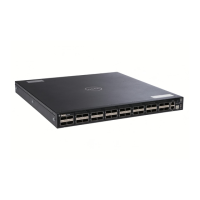
